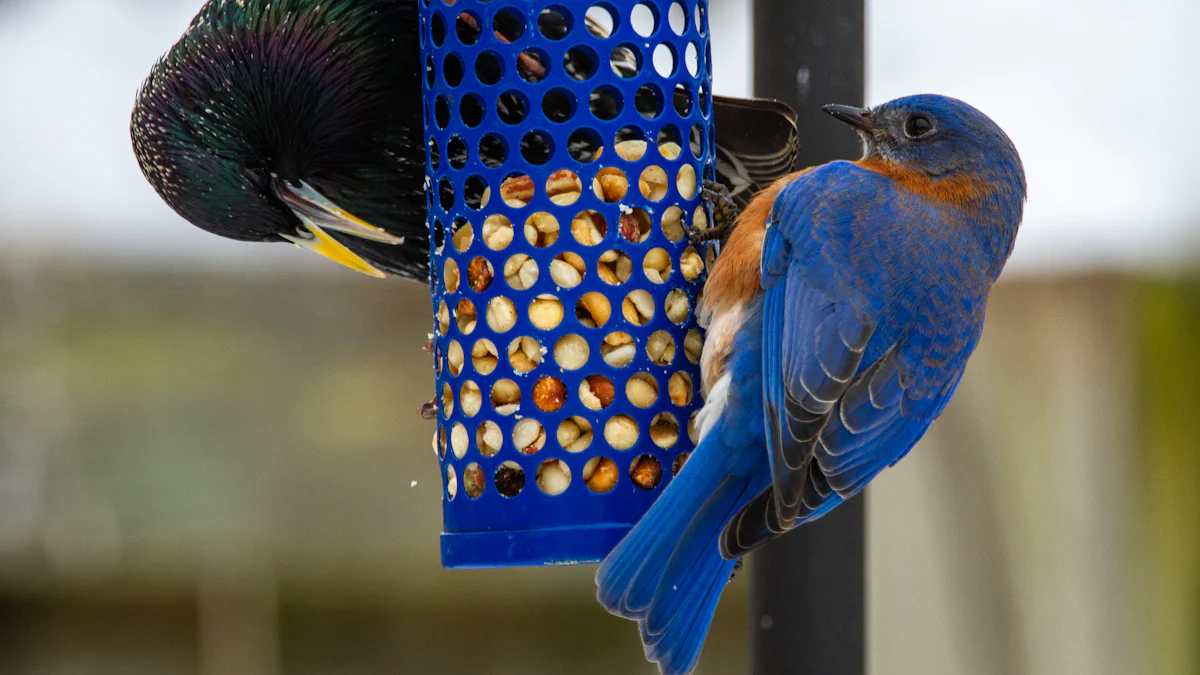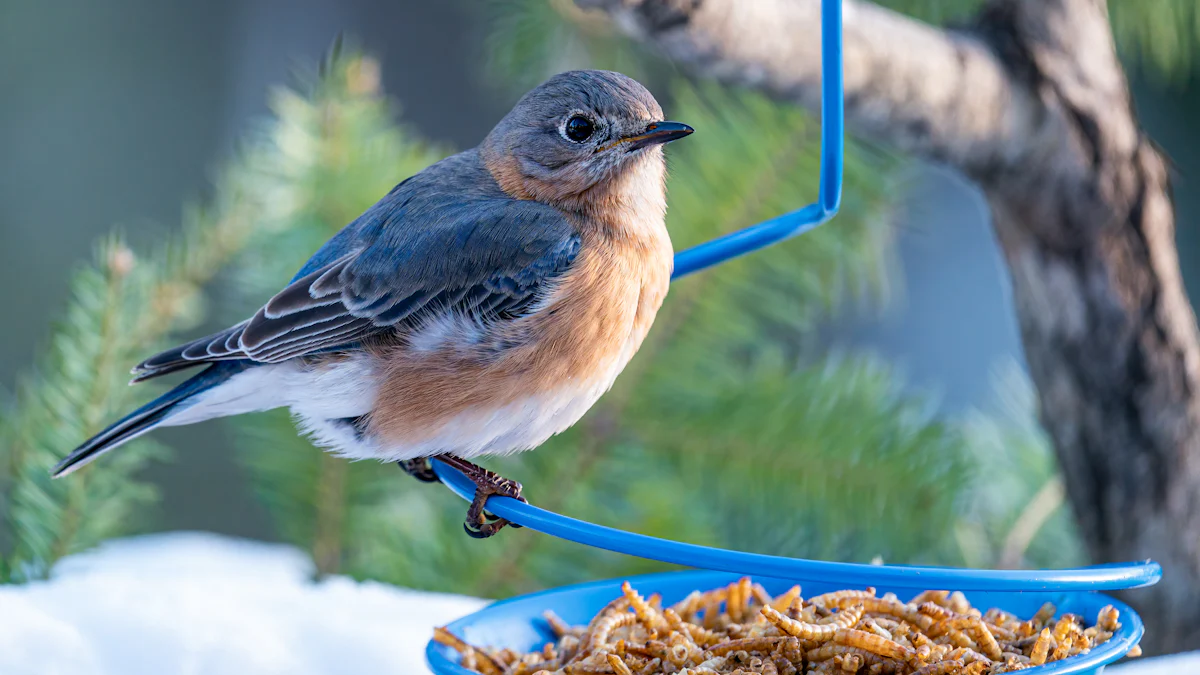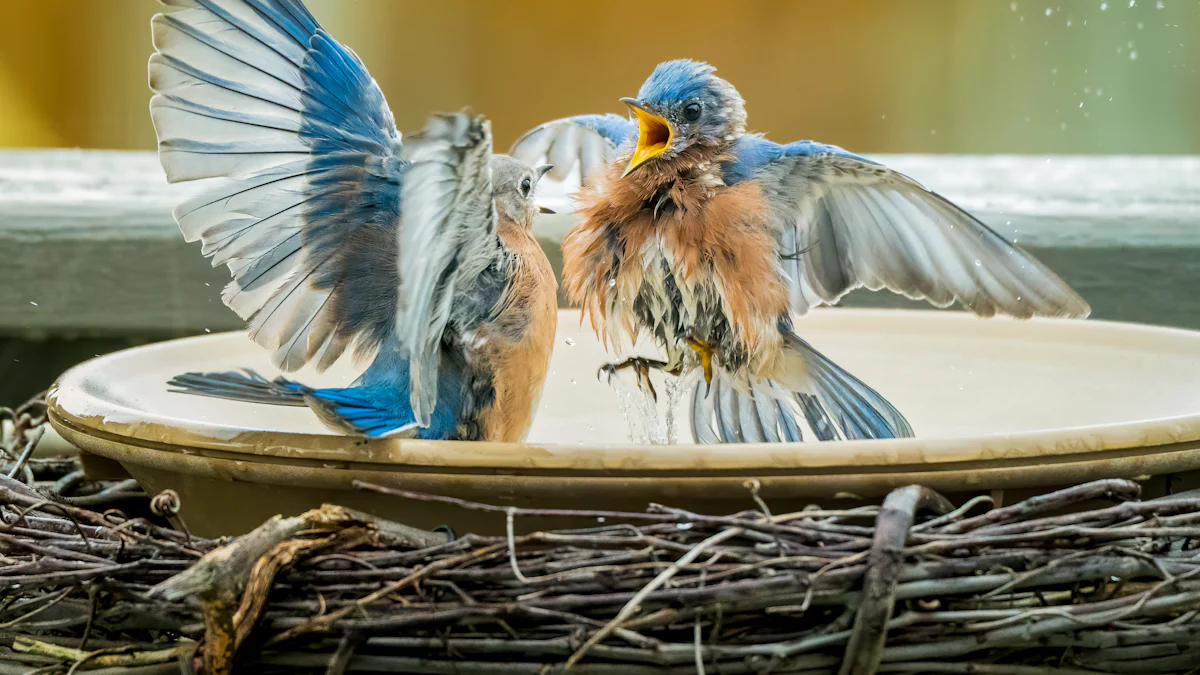
Dried mealworms for birds are a powerhouse of nutrition. Packed with 50% protein and 25% fat, they fuel energy, muscle growth, and warmth. These lightweight snacks stay fresh for months, making them perfect for year-round feeding. Whether it’s nesting, migrating, or molting season, they’re a simple, mess-free way to keep birds thriving.
Key Takeaways
- Dried mealworms are healthy snacks for birds. They have 50% protein and 25% fat, which help with energy and muscle building.
- They are simple to store and use. Keep them in a cool, dry spot to stay fresh.
- Adding dried mealworms to seeds or fruit brings more birds. This also gives birds a better mix of food.
Dried vs. Live Mealworms: Which is Better?
Advantages of dried mealworms for birds
Dried mealworms for birds are a game-changer when it comes to convenience and nutrition. They’re lightweight, easy to store, and mess-free. Unlike live mealworms, which can wriggle away or require special care, dried ones are ready to use whenever you need them. Plus, they pack a serious nutritional punch. With 53% protein and 28% fat, they provide birds with the energy they need for flying, nesting, or surviving colder months.
Another big advantage? You can feed them in multiple ways. Toss them into a feeder, scatter them on the ground, or even place them on a birdbath. If you’re putting them on the ground, choose a shady spot to keep them from overheating. This flexibility makes dried mealworms a favorite among bird enthusiasts.
Key differences between dried and live mealworms
When comparing dried and live mealworms, the nutritional differences stand out. Here’s a quick breakdown:
| Nutrient | Live Mealworms | Dried Mealworms |
|---|---|---|
| Moisture Content | 62% | 5% |
| Protein | 20% | 53% |
| Fat | 13% | 28% |
| Fiber | 2% | 6% |
Live mealworms have higher moisture content, which can be beneficial for hydration. However, dried mealworms offer significantly more protein and fat, making them a more concentrated energy source.
Why dried mealworms are a low-maintenance option
If you’re looking for a hassle-free way to feed birds, dried mealworms are the way to go. They don’t require refrigeration or special containers. You can store them in a cool, dry place, and they’ll stay fresh for months. They’re also less messy than live mealworms, which can escape or attract pests.
Dried mealworms are cost-effective too. Buying them in bulk saves money, and since they have a long shelf life, you won’t have to worry about waste. They’re also an eco-friendly choice, as they’re a sustainable protein source. Whether you’re a seasoned birdwatcher or just starting out, dried mealworms make feeding birds simple and enjoyable.
Which Birds Eat Dried Mealworms for Birds?

Common backyard birds that eat dried mealworms
You might be surprised by how many backyard birds love dried mealworms. These protein-packed snacks attract a variety of species, making your yard a lively birdwatching spot. Here’s a list of common backyard birds that enjoy them:
- Bluebirds
- Chickadees
- Thrushes
- Titmice
- Wrens
- Nuthatches
- Kinglets
If you’re just starting out with bird feeding, dried mealworms are a great way to bring these feathered friends to your yard. They’re especially appealing to insect-eating birds, so you’ll likely see more activity around your feeders.
Seasonal birds that benefit from dried mealworms
During migration, some birds need extra energy to fuel their long journeys. Warblers and orioles, for example, rely on nutrient-dense foods like dried mealworms to keep going. These snacks are rich in protein and fat, giving them the boost they need to complete their flights.
Seasonal visitors like robins and thrushes also benefit from dried mealworms, especially in early spring or colder months when natural food sources are scarce. By offering mealworms, you’re helping these birds stay strong and healthy during challenging times.
How dried mealworms help birds during nesting and migration
Nesting and migration are two of the most demanding periods in a bird’s life. Dried mealworms provide essential nutrients to support them during these times.
- The high protein content (about 50%) helps birds build muscle and repair tissues.
- Extra fat gives them the energy needed for activities like building nests and feeding chicks.
- The balanced amino acid profile in mealworms ensures birds get optimal nourishment.
For migratory birds, dried mealworms act as a compact, energy-rich food source. They help replenish energy reserves and keep birds fueled for their journeys. By adding dried mealworms to your feeders, you’re giving birds the support they need to thrive during these critical periods.
How to Store Dried Mealworms for Birds
Best practices for keeping dried mealworms fresh
Keeping dried mealworms fresh is easier than you might think. A few simple steps can go a long way in preserving their quality. First, store them in a cool place where the temperature stays between 40-50°F (4-10°C). This slows down any potential spoilage. Next, keep the environment dry. Too much moisture can lead to mold, so using a paper towel in the container helps absorb excess humidity. Ventilation is also key. Use a container with small holes to allow airflow and prevent condensation.
Avoid overcrowding the mealworms in one container. Overcrowding can trap heat, which might cause them to spoil faster. Regularly check the storage area for any changes in temperature or humidity. These small adjustments ensure your dried mealworms stay fresh for months.
Ideal storage containers and conditions
Choosing the right container makes all the difference. Plastic or glass containers work best because they’re durable and prevent pests from getting in. Make sure the container has smooth walls, as this keeps mealworms from escaping. A shallow container with a wide mouth is ideal since it allows heat to dissipate easily.
For long-term storage, pick a container with a tight-fitting lid but add small ventilation holes for airflow. Transparent containers are a bonus because they let you monitor the mealworms without opening the lid. Always store the container in a cool, dry place, like a pantry or refrigerator, to maintain freshness.
Signs that dried mealworms have gone bad
It’s important to know when dried mealworms are no longer safe for birds. Spoiled mealworms often have a foul or musty odor. Discoloration is another red flag—if they look darker or have unusual spots, it’s time to toss them. Mold is a clear sign of spoilage, usually caused by excess moisture.
Check the packaging too. If it’s damaged or exposed to air, the mealworms might have absorbed moisture, leading to spoilage. Always inspect your mealworms before feeding them to birds. Fresh mealworms should look dry, smell neutral, and feel crisp.
How to Serve Dried Mealworms for Birds

Types of feeders for serving dried mealworms
Choosing the right feeder makes a big difference when serving dried mealworms. Platform or tray feeders work best because they provide an open space for birds to land and feed comfortably. These feeders often come with small containers for mealworms, which don’t need to be large since birds typically eat around 100 mealworms daily. If you’re using live mealworms, make sure the container has sides at least 1 inch tall to prevent them from escaping.
Some feeders even have roofs or drainage holes to keep mealworms dry and mold-free. This is especially helpful during rainy weather. Platform feeders also encourage social feeding, allowing multiple birds to enjoy the mealworms at once. You can also find innovative designs with anti-squirrel features or weather-resistant materials to keep your feeding station secure and long-lasting.
How much to serve and the best times to feed
When it comes to serving dried mealworms, less is more. Birds don’t need large amounts—just a small handful in a feeder or mixed with other foods is enough. You can offer them year-round, but they’re especially important during winter when natural food sources are scarce. Spring and fall are also great times to serve mealworms, as migratory birds need high-protein snacks to replenish their energy.
For nesting birds in spring, mealworms provide essential nutrients for breeding and feeding their chicks. Try feeding birds early in the morning or late afternoon when they’re most active and searching for food.
Mixing dried mealworms with other bird foods
Mixing dried mealworms with other bird foods is a great way to attract a variety of species to your yard. Combine them with seeds, suet, or fruit to create a balanced and appealing menu. This not only diversifies the diet for birds but also ensures they get all the nutrients they need to stay healthy.
Here are some benefits of mixing mealworms with other foods:
- It keeps birds engaged and encourages them to return to your feeders.
- It provides a well-rounded diet, especially during demanding seasons like nesting or migration.
- It attracts a wider range of bird species, making your yard a lively birdwatching spot.
Whether you’re using a feeder, scattering mealworms on the ground, or placing them on a birdbath, mixing them with other foods ensures birds get the best of both worlds. Just remember to place ground mealworms in a shady spot to keep them from overheating.
Cost-Effective Ways to Use Dried Mealworms for Birds
Buying dried mealworms in bulk to save money
If you’re feeding birds regularly, buying dried mealworms in bulk is a smart move. Larger packs often come with a lower price per pound, making them much more economical than smaller packages. Over time, this can save you a significant amount of money. Plus, with the rising demand for alternative protein sources, prices may increase in the future. Stocking up now ensures you’re prepared without breaking the bank.
Bulk purchases also mean fewer trips to the store or online orders, saving you time and effort. Just make sure you store them properly in a cool, dry place to keep them fresh for months.
Combining dried mealworms with other affordable bird food
Stretch your budget further by mixing dried mealworms with other bird foods. This creates a nutrient-rich blend that attracts a variety of birds while keeping costs down. Here are some affordable combinations you can try:
- Mix mealworms with high-quality birdseed for a balanced diet.
- Pair them with suet cakes, especially during winter when birds need extra energy.
- Sprinkle mealworms over fruit slices like apples or oranges to entice fruit-loving species.
These combinations not only save money but also make your feeders more appealing to a wider range of birds.
Tips to avoid waste and maximize value
Avoiding waste is key to getting the most out of your dried mealworms. Start by offering small amounts to see how much your local birds eat. This prevents overfeeding and ensures nothing goes to waste.
Here’s a step-by-step guide to minimize waste:
- Begin with small portions and adjust based on bird activity.
- Use mealworms as a treat rather than replacing regular feed entirely.
- Choose the right feeding method, like a feeder or sprinkling them on the ground.
- Always provide fresh water nearby to help birds digest their food.
“Adding dried mealworms to your seed mix can entice new bird species to your feeders, enriching your birdwatching experience.”
To maximize value, store mealworms in an airtight container in a cool, dry spot. You can also establish a consistent feeding schedule. Birds will learn to visit your yard regularly, ensuring no food goes unnoticed.
Dried mealworms for birds are a simple yet powerful way to support your feathered visitors. They’re packed with protein and fat, making them an essential energy source for birds during nesting, migration, and even molting. Plus, they’re easy to store and serve, whether you use a feeder, a birdbath, or scatter them on the ground in a shady spot.
“Research shows that dried mealworms act as a compact, nutrient-rich energy source, making them indispensable for migratory birds.”
You’ll attract a variety of species, from insect-eating birds like woodpeckers and sparrows to seasonal visitors like robins.
- Easy ways to attract birds:
- Use specialized feeders to cater to specific species.
- Mix mealworms with seeds or fruit for a balanced diet.
- Establish a regular feeding schedule to make your yard a reliable food source.
| Nutritional Component | Value |
|---|---|
| Protein | Approximately 50% |
| Fat | Approximately 25% |
| Essential Nutrients | High |
By adding dried mealworms to your feeding routine, you’ll not only help birds thrive but also enjoy a more vibrant birdwatching experience. Why not give it a try and see how your yard transforms into a haven for birds?
FAQ
How can I feed dried mealworms to garden birds?
You can use a feeder, scatter them on the ground, or place them on a birdbath. For ground feeding, choose a shady spot to prevent overheating.
Can I mix dried mealworms with other bird food?
Absolutely! Combine them with seeds, suet, or fruit. This creates a balanced diet and attracts a variety of bird species to your yard.
How often should I feed birds dried mealworms?
Offer them daily in small amounts. Birds eat more during nesting, migration, or winter. Adjust portions based on how much they consume.


